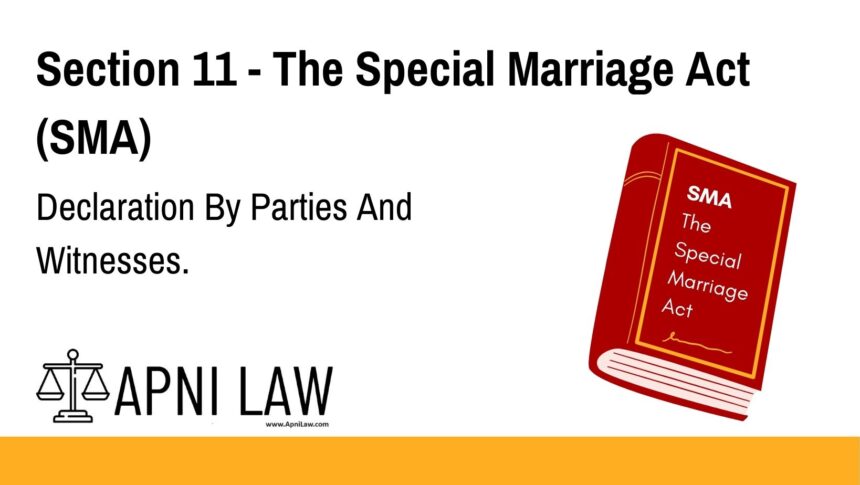Code: Section 11
Before the marriage is solemnized, the parties and three witnesses shall, in the presence of the Marriage Officer, sign a declaration in the form specified in the Third Schedule to this Act, and the declaration shall be countersigned by the Marriage Officer.
Explanation of Section 11 of the Special Marriage Act
Section 11 of the Special Marriage Act, 1954 is a mandatory procedural step before the actual solemnization of a marriage under this Act. It ensures that both parties and witnesses formally affirm the marriage with a written declaration in front of the Marriage Officer. This declaration is not just a ceremonial formality—it serves as a legal safeguard confirming consent and eligibility for marriage.
Key Provisions:
- The declaration must be signed by both parties intending to marry.
- Three witnesses are required to sign the declaration.
- The Marriage Officer must countersign the declaration.
- The declaration is made in the form prescribed in the Third Schedule of the Act.
- This step must be completed before the marriage is solemnized under the Act.
This provision promotes transparency and accountability and safeguards against fraud, coercion, or misrepresentation.
Illustration
Example 1: Marriage Under the Special Marriage Act
A couple—Raj and Aisha—have completed the 30-day notice period with the Marriage Officer as per Section 5 of the Special Marriage Act. On the day of solemnization, they appear with three adult witnesses. Before the ceremony, all five (the couple and three witnesses) sign a declaration in the presence of the Marriage Officer. The Officer countersigns the form. Only after this is the marriage legally solemnized under Section 12 of the Act.
Common Questions and Answers on Section 11 SMA
1. Why is the declaration required before solemnization?
It acts as a formal confirmation that both parties are entering into marriage willingly and meet all legal requirements. It also verifies the presence of witnesses, which adds legal weight to the process.
2. Who can be a witness for this declaration?
Any adult who is present and can verify the identity and consent of the parties. They must be competent to testify in a court of law.
3. Is this declaration a substitute for the marriage certificate?
No. The declaration is a prerequisite for solemnization. After the marriage is solemnized, a separate certificate of marriage is issued under Section 13.
4. Can a marriage proceed without this declaration?
No. Without this signed and countersigned declaration, the marriage cannot legally be solemnized under the Special Marriage Act.
5. What happens to the declaration document?
It is retained by the Marriage Officer and becomes part of the official marriage record maintained by the Registrar.
Conclusion
Section 11 of the Special Marriage Act, 1954 plays a crucial role in formalizing the intent of both parties to marry and involves witnesses to validate the process. It ensures transparency, legal formality, and protects the integrity of marriages conducted under this secular law. For a comprehensive guide to each section of the Special Marriage Act, explore ApniLaw today.
🔗 Explore more legal insights and bare acts at ApniLaw








